布洛芬合成工艺论文[1]
布洛芬合成生产实验报告(3篇)

第1篇一、实验目的本实验旨在通过化学合成方法制备布洛芬,并对其合成过程进行详细记录,以了解布洛芬的合成工艺及反应条件。
二、实验原理布洛芬(Ibuprofen)是一种非甾体抗炎药(NSAID),具有解热、镇痛、抗炎作用。
本实验采用芳基1,2-转位重排法合成布洛芬,以异丁基苯为起始原料,经过傅克反应、催化加氢、氧化、酸催化等步骤,最终得到目标产物。
三、实验材料与仪器1. 实验材料:(1)异丁基苯:分析纯(2)三氯化铝:分析纯(3)铁粉:分析纯(4)硝酸:分析纯(5)氢氧化钠:分析纯(6)无水乙醇:分析纯(7)水合肼:分析纯(8)硝酸银:分析纯2. 实验仪器:(1)圆底烧瓶(2)分液漏斗(3)滴液漏斗(4)冷凝管(5)锥形瓶(6)烧杯(7)抽滤瓶(8)干燥器(9)紫外-可见分光光度计(10)红外光谱仪四、实验步骤1. 傅克反应:将50 mL异丁基苯、10 mL三氯化铝和20 mL无水乙醇混合,加入三氯化铝,搅拌溶解。
然后将混合液滴加到装有20 mL三氯化铝和30 mL无水乙醇的圆底烧瓶中,加热回流1小时。
2. 催化加氢:将傅克反应得到的产物冷却至室温,过滤,用无水乙醇洗涤,干燥。
将得到的固体加入装有50 mL无水乙醇的圆底烧瓶中,加入5 g铁粉,加热回流3小时。
3. 氧化:将催化加氢得到的产物冷却至室温,过滤,用无水乙醇洗涤,干燥。
将得到的固体加入装有50 mL硝酸和20 mL水的烧杯中,加热回流2小时。
4. 酸催化:将氧化得到的产物冷却至室温,过滤,用无水乙醇洗涤,干燥。
将得到的固体加入装有50 mL水合肼和20 mL硝酸的烧杯中,加热回流2小时。
5. 纯化:将酸催化得到的产物冷却至室温,过滤,用无水乙醇洗涤,干燥。
将得到的固体加入装有50 mL硝酸银和20 mL水的烧杯中,加热回流2小时。
6. 结晶:将纯化得到的产物加入装有100 mL无水乙醇的烧杯中,冷却至室温,抽滤,干燥,得到布洛芬。
五、实验结果与分析1. 反应条件对产率的影响:(1)三氯化铝的用量:当三氯化铝用量从5 mL增加到10 mL时,产率从40%提高到60%。
布洛芬合成路线综述
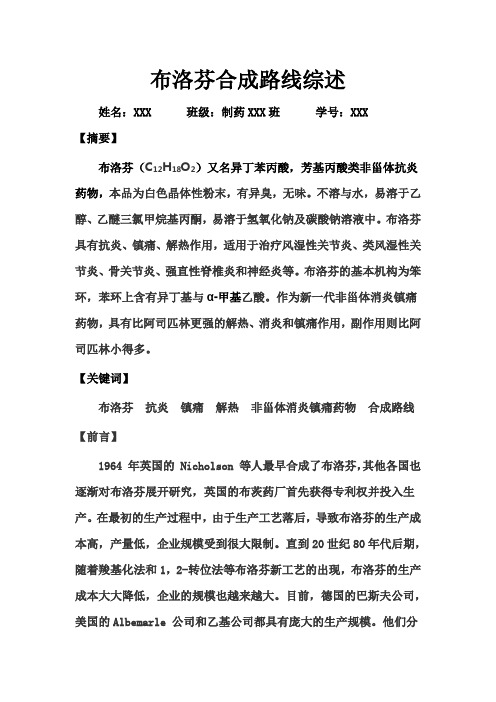
布洛芬合成路线综述姓名:XXX 班级:制药XXX班学号:XXX【摘要】布洛芬(C12H18O2)又名异丁苯丙酸,芳基丙酸类非甾体抗炎药物,本品为白色晶体性粉末,有异臭,无味。
不溶与水,易溶于乙醇、乙醚三氯甲烷基丙酮,易溶于氢氧化钠及碳酸钠溶液中。
布洛芬具有抗炎、镇痛、解热作用,适用于治疗风湿性关节炎、类风湿性关节炎、骨关节炎、强直性脊椎炎和神经炎等。
布洛芬的基本机构为笨环,苯环上含有异丁基与α-甲基乙酸。
作为新一代非甾体消炎镇痛药物,具有比阿司匹林更强的解热、消炎和镇痛作用,副作用则比阿司匹林小得多。
【关键词】布洛芬抗炎镇痛解热非甾体消炎镇痛药物合成路线【前言】1964 年英国的 Nicholson 等人最早合成了布洛芬,其他各国也逐渐对布洛芬展开研究,英国的布茨药厂首先获得专利权并投入生产。
在最初的生产过程中,由于生产工艺落后,导致布洛芬的生产成本高,产量低,企业规模受到很大限制。
直到20世纪80年代后期,随着羧基化法和1,2-转位法等布洛芬新工艺的出现,布洛芬的生产成本大大降低,企业的规模也越来越大。
目前,德国的巴斯夫公司,美国的Albemarle 公司和乙基公司都具有庞大的生产规模。
他们分别具有自己的核心技术,选择合适的工艺,从而具有经济效益和规模优势。
近十多年来,由于政府扶持,印度的医药工业发展迅速。
印度的 Sumitra 公司和 Cheminor 公司的生产规模也达到上述西方国家大公司的水平,而且由于印度的劳动力价格低廉,使得生产成本较低。
印度低价格的布洛芬大量出口,大大冲击了全球的布洛芬市场。
【研究现状】对于布洛芬这种医药结晶产品而言,质量的好坏对产品能否在国际市场竞争中占据有利地位往往起着重要的作用。
目前,国内布洛芬同国外同类产品相比存在着晶形不好、颗粒不均匀等质量方面的差距。
国内生产企业所使用的落后结晶技术与设备,一方面导致产品质量差,另一方面导致生产成本居高不下,使得国内布洛芬产品难以与国外产品相竞争,导致在国内市场和中国外的布洛芬产品占主导地位,如中美史可公司的布洛芬制剂占据了中国的70%的市场份额。
布洛芬的合成路线及设计
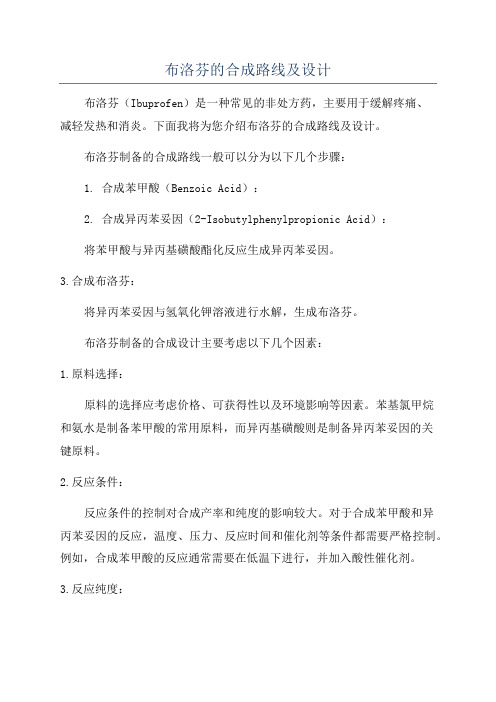
布洛芬的合成路线及设计布洛芬(Ibuprofen)是一种常见的非处方药,主要用于缓解疼痛、减轻发热和消炎。
下面我将为您介绍布洛芬的合成路线及设计。
布洛芬制备的合成路线一般可以分为以下几个步骤:1. 合成苯甲酸(Benzoic Acid):2. 合成异丙苯妥因(2-Isobutylphenylpropionic Acid):将苯甲酸与异丙基磺酸酯化反应生成异丙苯妥因。
3.合成布洛芬:将异丙苯妥因与氢氧化钾溶液进行水解,生成布洛芬。
布洛芬制备的合成设计主要考虑以下几个因素:1.原料选择:原料的选择应考虑价格、可获得性以及环境影响等因素。
苯基氯甲烷和氨水是制备苯甲酸的常用原料,而异丙基磺酸则是制备异丙苯妥因的关键原料。
2.反应条件:反应条件的控制对合成产率和纯度的影响较大。
对于合成苯甲酸和异丙苯妥因的反应,温度、压力、反应时间和催化剂等条件都需要严格控制。
例如,合成苯甲酸的反应通常需要在低温下进行,并加入酸性催化剂。
3.反应纯度:合成过程中的各个步骤对产品的纯度有较大的影响。
对于苯甲酸的合成,需要进行酯化反应后进行氧化反应,确保苯甲酸的纯度可以达到要求。
在合成布洛芬的过程中,水解反应的条件和酸碱平衡的控制也需要注意,以避免副产物的生成。
4.反应安全性:合成过程中需要注意反应条件的安全性,如控制反应温度和压力、防止火灾和爆炸等事故发生。
此外,对反应液的处理和废液的处理也需要符合环保要求,确保合成过程的安全性。
布洛芬的合成路线和设计需要综合考虑以上因素,并选择合适的化学反应和控制条件。
合成过程的优化可以提高产品的纯度和产率,降低成本,同时也需要注重反应安全和环保的要求。
通过不断的研究和改进,可以进一步提升合成路线和设计的效率和可持续性。
布洛芬生产工艺探索.doc

布洛芬生产工艺探索.doc布洛芬是一种解热镇痛的非处方药,它的主要成分是布洛芬胺。
此外,可以添加其它物质,如明胶、乳液、醋酸钠、乳糖、水杨酸等,用于制备不同规格的布洛芬。
布洛芬胶囊制剂的生产工艺可以大致分为选料、将原料制成粉末状、制备胶囊内容物、灌装胶囊、封制胶囊和组装成包装一次性的品种。
一、选料在生产布洛芬胶囊制剂的过程中,原料选料要求规范,所用物料要符合GMP要求,可以通过原料鉴定报告,清洁鉴别报告及毒理报告等相关报告确认其合格。
二、将原料制成粉末状将原料制成粉末状,可以采用细粉末机分散粉碎、球磨机研磨、注射器中研磨、串粉末等方法。
由于布洛芬胶囊制剂的性质比较特殊,因此在进行粉碎工艺时,要确保粉末的粒度小于46μm,平均粒径在30-45μm之间,使进行胶囊空心柱成型成为可能,保证合格质量。
三、制备胶囊内容物制备胶囊内容物,可采用速溶剂、注射剂、均质混合物等工艺。
首先,把适量的布洛芬粉加入注射器,搅拌均匀,然后把明胶、溶剂等其他物料添加,再搅拌均匀;最后把混合物置于坩埚中,放置于蒸煮消毒箱中,蒸煮一段时间后,完成制备胶囊内容物的工艺。
四、灌装胶囊灌装胶囊的工艺有大量的胶囊投料器(机器)可以选择,各种机器之间有很大的不同,可以根据生产企业的实际情况选择适合的机器。
五、封制胶囊封制胶囊一般采用熔融封制工艺,具体操作是将灌装完毕的胶囊进入胶囊封片机,将材料预加热至110-120℃,将各色封片就位,采用压力作用,使封片的面熔合以封制胶囊,最后放置在活动水槽里,进行清洗残渣处理。
六、组装成一次性的包装品种将经过上述工艺制备的胶囊放入一次性的包装品种中,根据包装品种的种类、尺寸选择对应的包装盒,然后将胶囊灌装到包装盒中,最后呈现完整、美观的规格,完成整个生产工艺。
以上是布洛芬胶囊制剂生产工艺的概要,生产工艺要求如下:上述每一道工序必须经过严格检查和评估;粉碎过程中加工小心,确保粒径及流动性;胶囊灌装要求准确;胶囊封制要求必须密封可靠;要求组装成的盒装品种整洁庄重。
布洛芬合成路线综述

布洛芬合成路线综述姓名:XXX 班级:制药XXX班学号:XXX【摘要】布洛芬(C12H18O2)又名异丁苯丙酸,芳基丙酸类非甾体抗炎药物,本品为白色晶体性粉末,有异臭,无味。
不溶与水,易溶于乙醇、乙醚三氯甲烷基丙酮,易溶于氢氧化钠及碳酸钠溶液中。
布洛芬具有抗炎、镇痛、解热作用,适用于治疗风湿性关节炎、类风湿性关节炎、骨关节炎、强直性脊椎炎和神经炎等。
布洛芬的基本机构为笨环,苯环上含有异丁基与α-甲基乙酸。
作为新一代非甾体消炎镇痛药物,具有比阿司匹林更强的解热、消炎和镇痛作用,副作用则比阿司匹林小得多。
【关键词】布洛芬抗炎镇痛解热非甾体消炎镇痛药物合成路线【前言】1964 年英国的Nicholson 等人最早合成了布洛芬,其他各国也逐渐对布洛芬展开研究,英国的布茨药厂首先获得专利权并投入生产。
在最初的生产过程中,由于生产工艺落后,导致布洛芬的生产成本高,产量低,企业规模受到很大限制。
直到20世纪80年代后期,随着羧基化法和1,2-转位法等布洛芬新工艺的出现,布洛芬的生产成本大大降低,企业的规模也越来越大。
目前,德国的巴斯夫公司,美国的Albemarle 公司和乙基公司都具有庞大的生产规模。
他们分别具有自己的核心技术,选择合适的工艺,从而具有经济效益和规模优势。
近十多年来,由于政府扶持,印度的医药工业发展迅速。
印度的Sumitra 公司和Cheminor 公司的生产规模也达到上述西方国家大公司的水平,而且由于印度的劳动力价格低廉,使得生产成本较低。
印度低价格的布洛芬大量出口,大大冲击了全球的布洛芬市场。
【研究现状】对于布洛芬这种医药结晶产品而言,质量的好坏对产品能否在国际市场竞争中占据有利地位往往起着重要的作用。
目前,国内布洛芬同国外同类产品相比存在着晶形不好、颗粒不均匀等质量方面的差距。
国内生产企业所使用的落后结晶技术与设备,一方面导致产品质量差,另一方面导致生产成本居高不下,使得国内布洛芬产品难以与国外产品相竞争,导致在国内市场和中国外的布洛芬产品占主导地位,如中美史可公司的布洛芬制剂占据了中国的70%的市场份额。
布洛芬的合成工艺研究
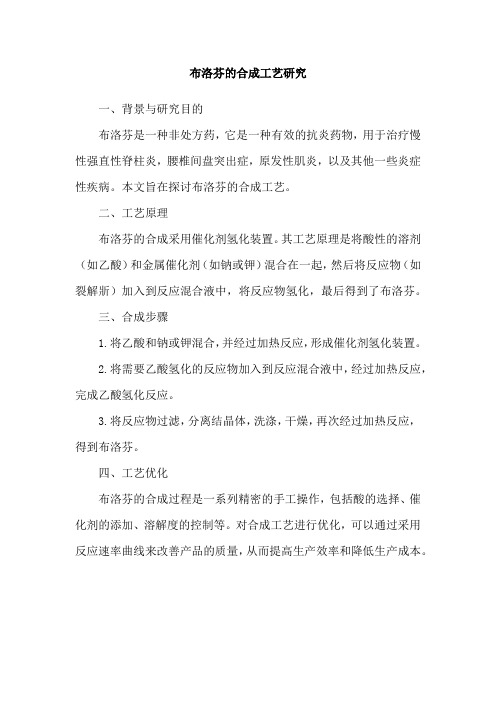
布洛芬的合成工艺研究
一、背景与研究目的
布洛芬是一种非处方药,它是一种有效的抗炎药物,用于治疗慢性强直性脊柱炎,腰椎间盘突出症,原发性肌炎,以及其他一些炎症性疾病。
本文旨在探讨布洛芬的合成工艺。
二、工艺原理
布洛芬的合成采用催化剂氢化装置。
其工艺原理是将酸性的溶剂(如乙酸)和金属催化剂(如钠或钾)混合在一起,然后将反应物(如裂解斨)加入到反应混合液中,将反应物氢化,最后得到了布洛芬。
三、合成步骤
1.将乙酸和钠或钾混合,并经过加热反应,形成催化剂氢化装置。
2.将需要乙酸氢化的反应物加入到反应混合液中,经过加热反应,完成乙酸氢化反应。
3.将反应物过滤,分离结晶体,洗涤,干燥,再次经过加热反应,得到布洛芬。
四、工艺优化
布洛芬的合成过程是一系列精密的手工操作,包括酸的选择、催化剂的添加、溶解度的控制等。
对合成工艺进行优化,可以通过采用反应速率曲线来改善产品的质量,从而提高生产效率和降低生产成本。
布洛芬新工艺研究
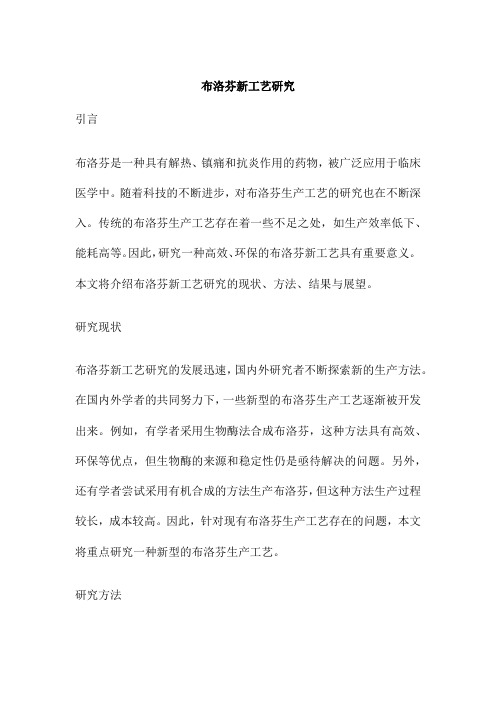
布洛芬新工艺研究引言布洛芬是一种具有解热、镇痛和抗炎作用的药物,被广泛应用于临床医学中。
随着科技的不断进步,对布洛芬生产工艺的研究也在不断深入。
传统的布洛芬生产工艺存在着一些不足之处,如生产效率低下、能耗高等。
因此,研究一种高效、环保的布洛芬新工艺具有重要意义。
本文将介绍布洛芬新工艺研究的现状、方法、结果与展望。
研究现状布洛芬新工艺研究的发展迅速,国内外研究者不断探索新的生产方法。
在国内外学者的共同努力下,一些新型的布洛芬生产工艺逐渐被开发出来。
例如,有学者采用生物酶法合成布洛芬,这种方法具有高效、环保等优点,但生物酶的来源和稳定性仍是亟待解决的问题。
另外,还有学者尝试采用有机合成的方法生产布洛芬,但这种方法生产过程较长,成本较高。
因此,针对现有布洛芬生产工艺存在的问题,本文将重点研究一种新型的布洛芬生产工艺。
研究方法本研究将采用文献调研和实验研究相结合的方法,首先通过文献调研了解布洛芬生产工艺的研究现状和进展,然后通过实验研究探索新型布洛芬生产工艺的可行性。
具体实验方案如下:1、材料:准备布洛芬原料、催化剂、溶剂等实验材料。
2、方法:采用液相催化氢化法合成布洛芬,通过调节反应温度、压力、催化剂用量等参数,探究最佳反应条件。
3、实验设计:进行不同条件下催化剂的活性评价实验,采用正交试验设计方法优选最佳反应条件。
4、数据处理:对实验数据进行整理和分析,采用表格和图表记录数据。
研究结果通过实验研究,我们发现新型布洛芬生产工艺具有以下优点:1、反应条件温和,催化剂活性高,可有效提高布洛芬的产率;2、反应过程易于控制,产品质量稳定,可实现工业化生产;3、催化剂可循环使用,减少了对环境的影响。
然而,新型布洛芬生产工艺也存在一些不足之处:1、催化剂成本较高,可能会增加生产成本;2、工艺流程仍较长,需要进一步优化简化。
结论与展望通过对布洛芬新工艺的研究,我们发现新型生产工艺具有较高的生产效率和环保性能。
虽然新型生产工艺仍存在一些不足之处,但可以通过进一步优化催化剂、简化工艺流程等措施加以改进。
以4-异丁基苯甲醛为原料合成布洛芬的研究
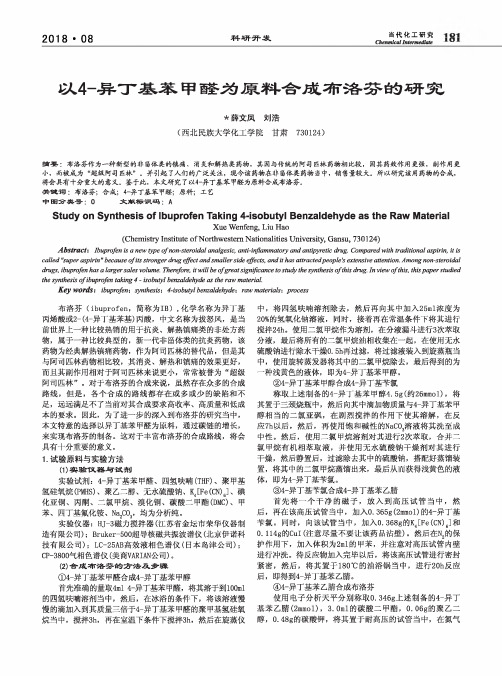
2018•08科研开发当代化工研究Chenmical I ntermediate丄〇丄以4-异丁基苯甲酸为原料合成布洛芬的研究*薛文凤刘浩(西北民族大学化工学院甘肃730124)搞要:布洛芬作为一种新型的非甾体类的镇痛、消炎和解热类药物,其因与传统的阿司匹林药物相比较,因其药效作用更强,副作用更 小,而被成为“超级阿司匹林”。
并引起了人们的广泛关注,现今该药物在非甾体类药物当中,销售量较大。
所以研究该用药物的合成,将会具有十分重大的意义•鉴于此,本文研究了以4-异丁基苯曱醛为原料合成布洛芬。
关键词:布洛芬;合成;4-异丁基苯曱醛;原料;工艺中图分类号:0文献标识码:AStudy on Synthesis of Ibuprofen Taking 4-isobutyl Benzaldehyde as the Raw MaterialXue Wenfeng,Liu Hao(Chemistry Institute of Northwestern Nationalities University,Gansu,730124) Abstract: Ibuprofen is a new type o f n on-steroidal analgesic, anti-inflam m atory and antipyretic drug. Compared w ith tra d itio n a l asp irin, it is called "super a sp irin” because o f i ts stronger drug effect and s m aller side effects, and it has attractedpeople's extensive attention. Among non-steroidal drugs, ibuprofen has a la rge r sales volume. Therefore, it w ill be o fg re a t s ignificance to study the synthesisof t his drug. In view o f t his, th is p aper studiedthe synthesis o f i buprofen taking 4 - isobutyl benzaldehyde as the raw m aterial.Key wordsi i b uprofen% synthesis\ 4-isobutyl benzaldehyde% raw m aterials\ process布洛芬(ibuprofen,简称为IB),化学名称为异丁基 丙稀酸或2-(4-异丁基苯基)丙酸,中文名称为拔怒风,是当前世界上一种比较热销的用于抗炎、解热镇痛类的非处方药 物,属于一种比较典型的,新一代非甾体类的抗炎药物,该药物为经典解热镇痛药物,作为阿司匹林的替代品,但是其 与阿司匹林药物相比较,其消炎、解热和镇痛的效果更好,而且其副作用相对于阿司匹林来说更小,常常被誉为“超级阿司匹林”。
布洛芬合成论文

布洛芬合成工艺的研究引言布洛芬是世界卫生组织、美国FDA唯一共同推荐的儿童退烧药,是公认的儿童首选抗炎药。
布洛芬具有抗炎、镇痛、解热作用。
治疗风湿和类风湿关节炎的疗效稍逊于乙酰水杨酸和保泰松。
适用于治疗风湿性关节炎、类风湿性关节炎、骨关节炎、强直性脊椎炎和神经炎等。
摘要布洛芬(ibuprofen),化学名为2一(4一异丁基苯基)丙酸,为新一代非甾体消炎镇痛药物,具有比阿司匹林更强的解热、消炎和镇痛作用,副作用则比阿司匹林小得多。
因此自上世纪70年代末上市以来,以其疗效高, 副作用小为特点而而获得了迅速发展,现已成为生产量和使用量最大的消炎解热镇痛药之一。
1987 年, 它在全部解热镇痛消炎药物的23 亿美元销售额中占18%的份额。
1993 年上升至30%以上。
目前,全世界布洛芬的总产量为8000 吨左右。
布洛芬的合成方法主要包括:(1)转位重排法;(2) 醇羰基化法;(3)烯烃羰基化法;(4) 卤代烃羰基化法;(5) 烯烃加氢法;(6)环氧丙烷重排法等。
本文以对异丁基苯甲醛为原料,分5步来合成布洛芬。
考察了反应气氛、温度、催化剂的量、溶剂等反应条件对反应的影响。
论文在对K4[Fe(CN)6]性质和苄氯氰化反应特点进行分析的基础之上,引入催化的方式,以无毒K4[Fe(CN)6]作为氰化试剂,实现了苄氯氰化反应中氰化试剂的无毒化,为苄氯向苯乙腈类化合物的转化探索了一种相对绿色的新方法。
温度对反应的影响如下:随着温度的升高,产率也随之升高。
但是,当反应温度高于某一反应温度时,产率又有所下降。
从动力学角度分析,我们可以知道:随着反应温度的升高,反应活性即反应速率也升高,催化剂的催化效率也升高,反应收到的产率也升高。
在某一温度附近达到最优化,之后继续升温使催化剂部分容易失活,并生成了其它副产物,反应的产率也随之下降。
因此该反应的最优反应温度是180 ℃。
在最优反应温度下,苯乙腈的产率可以达到97.8%。
考察了反应气氛对反应的影响。
布洛芬生产工艺论文

布洛芬生产工艺论文布洛芬是一种常用的非甾体抗炎药(NSAID),广泛用于缓解疼痛和降低发热。
本文将介绍布洛芬的生产工艺过程。
1. 初步原料的准备布洛芬的原料包括苯甲酸、乙酰氯和碳酸钾。
首先,苯甲酸与乙酰氯经过酰化反应生成苯甲酸乙酯;然后,苯甲酸乙酯与碳酸钾反应生成布洛芬。
反应方程式如下:苯甲酸 + 乙酰氯→ 苯甲酸乙酯苯甲酸乙酯 + 碳酸钾→ 布洛芬 + 乙醇2. 反应过程将苯甲酸、乙酰氯和甲苯等溶剂加入反应釜中,加热并搅拌,使其均匀混合。
然后,将碳酸钾溶液缓慢加入反应釜中,同时保持反应温度在50-60℃之间。
反应结束后,将反应液降温至室温。
3. 结晶与过滤将反应液加入结晶反应器中,并加入少量乙醇。
反应液逐渐结晶,生成布洛芬晶体。
然后,使用过滤器将布洛芬晶体与溶剂分离。
它们分别获得布洛芬晶体和含有未反应物的滤液。
4. 干燥与粉碎将布洛芬晶体置于干燥箱中,在适当的温度下进行干燥,直至得到干燥的布洛芬颗粒。
然后,使用粉碎机将布洛芬颗粒粉碎成所需的粒度。
5. 包装与储存将粉碎的布洛芬颗粒进行包装,常见的包装形式为药品胶囊、药片或颗粒。
完成包装后,将布洛芬产品存放在干燥、遮光和通风良好的仓库中,以确保其质量和稳定性。
需要注意的是,布洛芬生产工艺中的每个步骤都需要严格控制温度、反应时间和反应物的比例,以确保产品的纯度和质量。
此外,还需要进行严格的质量检验,包括对原料、中间产物和最终产品的检测,以确保符合药品质量标准。
总结起来,布洛芬的生产工艺包括原料准备、反应过程、结晶与过滤、干燥与粉碎、包装与储存。
严格控制每个步骤的条件和质量检验是保证布洛芬产品质量的关键。
希望本文对布洛芬生产工艺的理解有所帮助。
布洛芬合成工艺

布洛芬合成工艺布洛芬合成工艺是一种复杂的有机反应,它主要用于合成苯乙酸布洛芬(ibuprofen)和其他衍生物。
它是一种经典的研究反应,近年来得到了广泛的应用。
布洛芬合成工艺首先将吡啶和丙酮经过异丙基氯化反应转化为异丙基氯化物。
然后在此反应中加入碳酸亚胺,将异丙基氯化物反应为异丙基氯酸,再将异丙基氯酸通过羟基化反应与乙二醇反应生成异丙基乙酸。
最后,将异丙基乙酸通过汞(II)氰化反应转化为苯乙酸布洛芬(ibuprofen)。
整个工艺从吡啶到苯乙酸布洛芬(ibuprofen)的转化,一共需要7步反应,其中每一步反应都需要准备当量的试剂,并且有关反应温度、时间、pH值等都要精确控制,这样才能保证反应的高效率和成活率。
第一步:吡啶和丙酮反应,在氯仿存在下由异丙基氯化反应产生异丙基氯化物。
第二步:将异丙基氯化物和碳酸亚胺反应,生成异丙基氯酸。
第三步:将异丙基氯酸反应与乙二醇,经羟基化反应生成异丙基乙酸。
第四步:将异丙基乙酸与汞(II)氰化反应,生成苯乙酸布洛芬(ibuprofen)。
布洛芬合成工艺不但要求反应条件准确,而且还要求良好的操作技巧。
在反应的过程中,使用的盐和有机溶剂必须严格控制浓度,以保证反应的有效性和稳定性,并尽可能减少浪费和污染。
此外,为了避免反应中的有机溶剂污染,在反应过程中可以采用蒸馏、萃取、分离等多种方法,以达到净化的目的。
另外,布洛芬合成工艺还要求在反应的过程中,要经常对反应溶液进行检测,以便于检验反应是否发生,并判断反应的效率和收率。
这些检测可以通过原子吸收光谱(AAS)等实验技术来进行,以确保反应的顺利进行。
总之,布洛芬合成工艺是一种复杂的有机反应,它主要用于合成苯乙酸布洛芬(ibuprofen)和其他衍生物。
它要求反应条件准确,并且操作技巧要熟练,在反应过程中要控制好反应温度和时间,并且进行定期的检测,以确保反应的顺利进行。
布洛芬合成工艺路线

布洛芬合成工艺路线布洛芬,这可是个大名鼎鼎的家伙,在缓解疼痛和退烧方面那可是一把好手!要说它的合成工艺路线,那可真是有点门道。
咱先来说说这合成的起始材料,就好像盖房子得先有砖头一样,选对了材料那是成功的第一步。
要是材料不对,就好比你想做糖醋排骨却买成了五花肉,那能行吗?然后呢,经过一系列复杂又神奇的化学反应。
这化学反应就像是一场精心编排的舞蹈,每个步骤都得精准无误。
比如说有氧化反应,这就好比是给原材料穿上一件新衣服,让它有了新的面貌。
还有还原反应,像是给这个新面貌进行了一番精装修,变得更加完美。
在这过程中,温度、压力、反应时间,每一个因素都至关重要。
温度高了,可能就把东西给烧糊了;温度低了,反应又进行不下去,这不就跟做饭火候没掌握好一样?压力也是,太大了可能会“爆炸”,太小了又达不到效果,多让人头疼啊!反应时间也得拿捏得死死的。
时间短了,反应不充分;时间长了,又浪费时间和资源。
这就好比你煮饺子,时间短了饺子皮还是生的,时间长了饺子都煮破了,多糟心!还有啊,各种催化剂的使用也很关键。
催化剂就像是化学反应中的小精灵,能让反应进行得又快又好。
但是选不对催化剂,那可就麻烦大了,就像找错了领路人,带你走进了死胡同。
在整个合成工艺路线中,每一步都得小心翼翼,如同走钢丝一般。
稍有差错,可能就会前功尽弃。
这就好像是一场精密的手术,主刀医生必须全神贯注,不能有丝毫的马虎。
最后经过一系列的分离、提纯等操作,才能得到我们想要的纯净的布洛芬。
这就像是从一堆沙子里淘出金子一样,需要耐心和精细的操作。
总之,布洛芬的合成工艺路线是一个极其复杂又精细的过程,需要科学家们的智慧和严谨,才能让这个“止痛退烧的小能手”来到我们身边,为我们的健康保驾护航!。
布洛芬的合成工艺研究
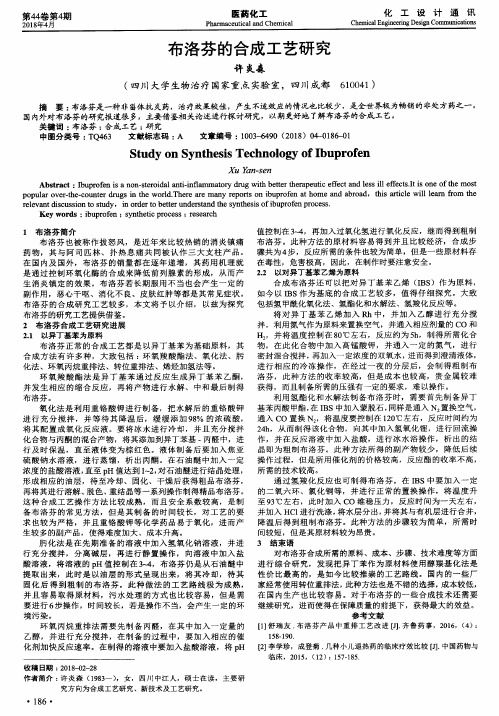
行 及 时 保 温 , 直 至 液 体 变 为 棕 红 色 。 液 体 制 备 后 要 加 入 焦 亚 晶即为 粗制 布洛芬 。此种 方法 所得 的副产 物较 少,降低 后续
环 氧羧 酸 酯 法是 异 丁基 苯 通过 反 应 生成 异 丁基 苯 乙酮 , 洛芬 ,此 种方法 的收 率较 高,但 是成本 也较 高,贵 金属较 难
并发 生相 应 的缩合 反应 ,再将 产物 进行水 解、 中和最 后制 得 获得 ,而且制 备所 需的压强有一定的要求 ,难 以操作 。
布 洛 芬 。
拌 ,利用氮气 作为原料来置换空气 ,并通入相 应剂量的 CO和 H,,并将温 度控制 在 80 ̄C左右 ,反 应约 为 5h,制得 所 需化 合
布 洛 芬 正 常 的 合 成 工 艺 都 是 以 异 丁 基 苯 为 基 础 原 料 , 其 物 ,在此 化合物 中加 入高 锰酸 钾,并通 入一 定 的氮 气 ,进 行
Study on Synthesis Technology of Ibuprofen
X u Yah—sen
Abstract:Ibuprofen is a non.steroidal anti.inflam matory drug with beRer therapeutic effect a n d less ill effects.It is one of the most popular over-t he.counter drugs in the world.There are man y repots on ibuprofen at hom e a n d abroad, this article will learn from the relevant discussion to study, in order to beRer un derstand the synthesis ofibuprofen process.
布洛芬的合成及应用研究进展
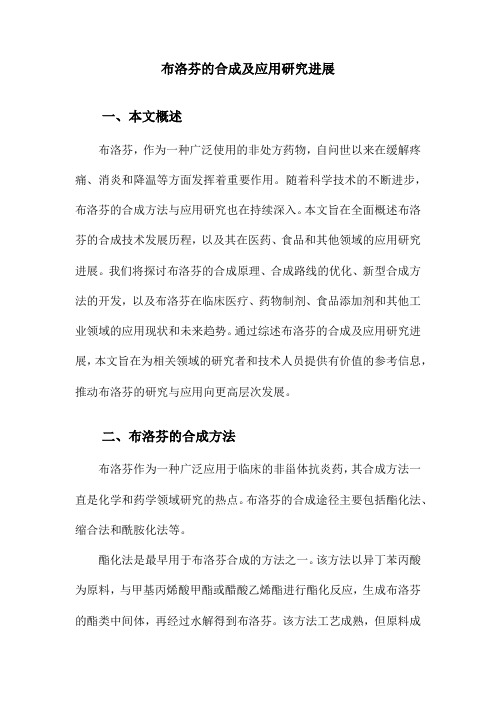
布洛芬的合成及应用研究进展一、本文概述布洛芬,作为一种广泛使用的非处方药物,自问世以来在缓解疼痛、消炎和降温等方面发挥着重要作用。
随着科学技术的不断进步,布洛芬的合成方法与应用研究也在持续深入。
本文旨在全面概述布洛芬的合成技术发展历程,以及其在医药、食品和其他领域的应用研究进展。
我们将探讨布洛芬的合成原理、合成路线的优化、新型合成方法的开发,以及布洛芬在临床医疗、药物制剂、食品添加剂和其他工业领域的应用现状和未来趋势。
通过综述布洛芬的合成及应用研究进展,本文旨在为相关领域的研究者和技术人员提供有价值的参考信息,推动布洛芬的研究与应用向更高层次发展。
二、布洛芬的合成方法布洛芬作为一种广泛应用于临床的非甾体抗炎药,其合成方法一直是化学和药学领域研究的热点。
布洛芬的合成途径主要包括酯化法、缩合法和酰胺化法等。
酯化法是最早用于布洛芬合成的方法之一。
该方法以异丁苯丙酸为原料,与甲基丙烯酸甲酯或醋酸乙烯酯进行酯化反应,生成布洛芬的酯类中间体,再经过水解得到布洛芬。
该方法工艺成熟,但原料成本较高,且存在环境污染问题。
缩合法是近年来发展起来的布洛芬合成新方法。
该法以异丁苯丙酸和甲醇为原料,通过缩合反应直接生成布洛芬。
该方法原料便宜易得,反应条件温和,且反应过程中无副产物生成,有利于环保和工业生产。
酰胺化法则是利用异丁苯丙酸与氨或胺类化合物进行酰胺化反应,生成布洛芬的酰胺中间体,再经过水解得到布洛芬。
该方法选择性较高,但反应条件较为苛刻,需要高温高压或催化剂的使用。
随着科学技术的进步,还有一些新兴的合成方法如微波辅助合成、超声波合成等被应用于布洛芬的合成中,这些方法具有反应时间短、能耗低、产物纯度高等优点,为布洛芬的工业化生产提供了新的思路。
布洛芬的合成方法多种多样,每种方法都有其独特的优点和适用条件。
在实际生产中,应根据原料成本、设备条件、环保要求等因素综合考虑,选择最适合的合成方法。
随着科技的不断进步,未来布洛芬的合成方法将会更加高效、环保和经济。
学年论文_布洛芬的合成研究
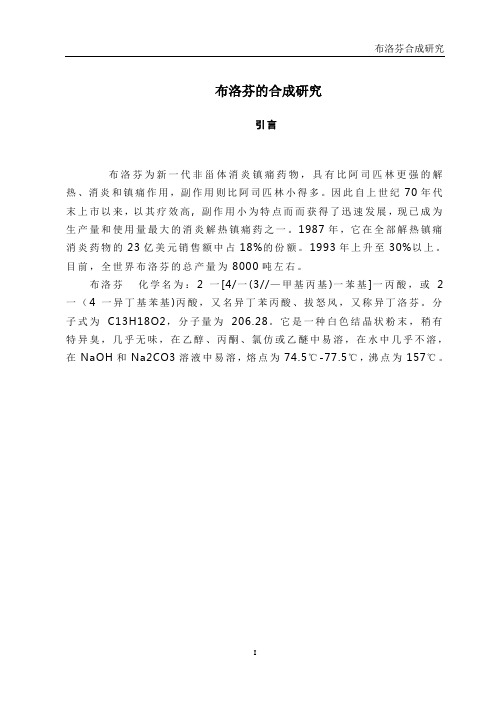
布洛芬的合成研究引言布洛芬为新一代非甾体消炎镇痛药物,具有比阿司匹林更强的解热、消炎和镇痛作用,副作用则比阿司匹林小得多。
因此自上世纪70年代末上市以来,以其疗效高, 副作用小为特点而而获得了迅速发展,现已成为生产量和使用量最大的消炎解热镇痛药之一。
1987年,它在全部解热镇痛消炎药物的23亿美元销售额中占18%的份额。
1993年上升至30%以上。
目前,全世界布洛芬的总产量为8000吨左右。
布洛芬化学名为:2一[4/一(3//—甲基丙基)一苯基]一丙酸,或2一(4一异丁基苯基)丙酸,又名异丁苯丙酸、拔怒风,又称异丁洛芬。
分子式为C13H18O2,分子量为206.28。
它是一种白色结晶状粉末,稍有特异臭,几乎无味,在乙醇、丙酮、氯仿或乙醚中易溶,在水中几乎不溶,在NaOH和Na2CO3溶液中易溶,熔点为74.5℃-77.5℃,沸点为157℃。
布洛芬的合成研究摘要:布洛芬(ibuprofen),为新一代非甾体消炎镇痛药物,具有比阿司匹林更强的解热、消炎和镇痛作用,副作用则比阿司匹林小得多。
本文从它的作用机理,应用现状,制备方法,以及发展前景等方面做了简要综述。
关键字:非甾体消炎镇痛药物布洛芬合成羰基化绿色化学目录第一章前言 (1)第二章作用机理 (1)第三章布洛芬生产现状及其存在问题 (1)第四章布洛芬的合成 (2)4.1转位重排法 (2)4.2醇羰基化法 (3)4.3烯烃羰基化法 (4)4.4卤代烃羰基化法 (4)4.5烯烃催化加氢法 (5)4.6环氧丙烷重排法 (6)4.7对异丁基苯乙烯手性羰化 (7)第五章结束语 (7)第一章前言1964 年英国的Nicholson 等人最早合成了布洛芬,其他各国也逐渐对布洛芬展开研究,英国的布茨药厂首先获得专利权并投入生产。
在最初的生产过程中,由于生产工艺落后,导致布洛芬的生产成本高,产量低,企业规模受到很大限制。
直到20世纪80年代后期,随着羧基化法和1,2-转位法等布洛芬新工艺的出现,布洛芬的生产成本大大降低,企业的规模也越来越大。
布洛芬合成路线综述之欧阳化创编

2021.02.06布洛芬合成路线综述姓名:XXX班级:制药XXX班学号:XXX【摘要】布洛芬(C12H18O2)又名异丁苯丙酸,芳基丙酸类非甾体抗炎药物,本品为白色晶体性粉末,有异臭,无味。
不溶与水,易溶于乙醇、乙醚三氯甲烷基丙酮,易溶于氢氧化钠及碳酸钠溶液中。
布洛芬具有抗炎、镇痛、解热作用,适用于治疗风湿性关节炎、类风湿性关节炎、骨关节炎、强直性脊椎炎和神经炎等。
布洛芬的基本机构为笨环,苯环上含有异丁基与α-甲基乙酸。
作为新一代非甾体消炎镇痛药物,具有比阿司匹林更强的解热、消炎和镇痛作用,副作用则比阿司匹林小得多。
【关键词】布洛芬抗炎镇痛解热非甾体消炎镇痛药物合成路线【前言】1964 年英国的Nicholson 等人最早合成了布洛芬,其他各国也逐渐对布洛芬展开研究,英国的布茨药厂首先获得专利权并投入生产。
在最初的生产过程中,由于生产工艺落后,导致布洛芬的生产成本高,产量低,企业规模受到很大限制。
直到20世纪80年代后期,随着羧基化法和1,2-转位法等布洛芬新工艺的出现,布洛芬的生产成本大大降低,企业的规模也越来越大。
目前,德国的巴斯夫公司,美国的Albemarle 公司和乙基公司都具有庞大的生产规模。
他们分别具有自己的核心技术,选择合适的工艺,从而具有经济效益和规模优势。
近十多年来,由于政府扶持,印度的医药工业发展迅速。
印度的Sumitra 公司和Cheminor 公司的生产规模也达到上述西方国家大公司的水平,而且由于印度的劳动力价格低廉,使得生产成本较低。
印度低价格的布洛芬大量出口,大大冲击了全球的布洛芬市场。
【研究现状】对于布洛芬这种医药结晶产品而言,质量的好坏对产品能否在国际市场竞争中占据有利地位往往起着重要的作用。
目前,国内布洛芬同国外同类产品相比存在着晶形不好、颗粒不均匀等质量方面的差距。
国内生产企业所使用的落后结晶技术与设备,一方面导致产品质量差,另一方面导致生产成本居高不下,使得国内布洛芬产品难以与国外产品相竞争,导致在国内市场和中国外的布洛芬产品占主导地位,如中美史可公司的布洛芬制剂占据了中国的70%的市场份额。
布洛芬合成路线综述之欧阳法创编

布洛芬合成路线综述姓名:XXX班级:制药XXX班学号:XXX【摘要】布洛芬(C12H18O2)又名异丁苯丙酸,芳基丙酸类非甾体抗炎药物,本品为白色晶体性粉末,有异臭,无味。
不溶与水,易溶于乙醇、乙醚三氯甲烷基丙酮,易溶于氢氧化钠及碳酸钠溶液中。
布洛芬具有抗炎、镇痛、解热作用,适用于治疗风湿性关节炎、类风湿性关节炎、骨关节炎、强直性脊椎炎和神经炎等。
布洛芬的基本机构为笨环,苯环上含有异丁基与α-甲基乙酸。
作为新一代非甾体消炎镇痛药物,具有比阿司匹林更强的解热、消炎和镇痛作用,副作用则比阿司匹林小得多。
【关键词】布洛芬抗炎镇痛解热非甾体消炎镇痛药物合成路线【前言】1964 年英国的Nicholson 等人最早合成了布洛芬,其他各国也逐渐对布洛芬展开研究,英国的布茨药厂首先获得专利权并投入生产。
在最初的生产过程中,由于生产工艺落后,导致布洛芬的生产成本高,产量低,企业规模受到很大限制。
直到20世纪80年代后期,随着羧基化法和1,2-转位法等布洛芬新工艺的出现,布洛芬的生产成本大大降低,企业的规模也越来越大。
目前,德国的巴斯夫公司,美国的Albemarle 公司和乙基公司都具有庞大的生产规模。
他们分别具有自己的核心技术,选择合适的工艺,从而具有经济效益和规模优势。
近十多年来,由于政府扶持,印度的医药工业发展迅速。
印度的Sumitra 公司和Cheminor 公司的生产规模也达到上述西方国家大公司的水平,而且由于印度的劳动力价格低廉,使得生产成本较低。
印度低价格的布洛芬大量出口,大大冲击了全球的布洛芬市场。
【研究现状】对于布洛芬这种医药结晶产品而言,质量的好坏对产品能否在国际市场竞争中占据有利地位往往起着重要的作用。
目前,国内布洛芬同国外同类产品相比存在着晶形不好、颗粒不均匀等质量方面的差距。
国内生产企业所使用的落后结晶技术与设备,一方面导致产品质量差,另一方面导致生产成本居高不下,使得国内布洛芬产品难以与国外产品相竞争,导致在国内市场和中国外的布洛芬产品占主导地位,如中美史可公司的布洛芬制剂占据了中国的70%的市场份额。
布洛芬合成路线综述
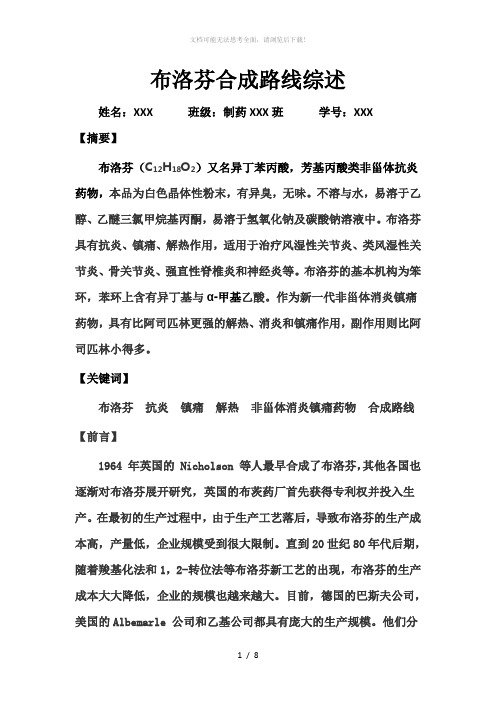
布洛芬合成路线综述姓名:XXX 班级:制药XXX班学号:XXX【摘要】布洛芬(C12H18O2)又名异丁苯丙酸,芳基丙酸类非甾体抗炎药物,本品为白色晶体性粉末,有异臭,无味。
不溶与水,易溶于乙醇、乙醚三氯甲烷基丙酮,易溶于氢氧化钠及碳酸钠溶液中。
布洛芬具有抗炎、镇痛、解热作用,适用于治疗风湿性关节炎、类风湿性关节炎、骨关节炎、强直性脊椎炎和神经炎等。
布洛芬的基本机构为笨环,苯环上含有异丁基与α-甲基乙酸。
作为新一代非甾体消炎镇痛药物,具有比阿司匹林更强的解热、消炎和镇痛作用,副作用则比阿司匹林小得多。
【关键词】布洛芬抗炎镇痛解热非甾体消炎镇痛药物合成路线【前言】1964 年英国的 Nicholson 等人最早合成了布洛芬,其他各国也逐渐对布洛芬展开研究,英国的布茨药厂首先获得专利权并投入生产。
在最初的生产过程中,由于生产工艺落后,导致布洛芬的生产成本高,产量低,企业规模受到很大限制。
直到20世纪80年代后期,随着羧基化法和1,2-转位法等布洛芬新工艺的出现,布洛芬的生产成本大大降低,企业的规模也越来越大。
目前,德国的巴斯夫公司,美国的Albemarle 公司和乙基公司都具有庞大的生产规模。
他们分别具有自己的核心技术,选择合适的工艺,从而具有经济效益和规模优势。
近十多年来,由于政府扶持,印度的医药工业发展迅速。
印度的 Sumitra 公司和 Cheminor 公司的生产规模也达到上述西方国家大公司的水平,而且由于印度的劳动力价格低廉,使得生产成本较低。
印度低价格的布洛芬大量出口,大大冲击了全球的布洛芬市场。
【研究现状】对于布洛芬这种医药结晶产品而言,质量的好坏对产品能否在国际市场竞争中占据有利地位往往起着重要的作用。
目前,国内布洛芬同国外同类产品相比存在着晶形不好、颗粒不均匀等质量方面的差距。
国内生产企业所使用的落后结晶技术与设备,一方面导致产品质量差,另一方面导致生产成本居高不下,使得国内布洛芬产品难以与国外产品相竞争,导致在国内市场和中国外的布洛芬产品占主导地位,如中美史可公司的布洛芬制剂占据了中国的70%的市场份额。
布洛芬合成路线综述之欧阳语创编
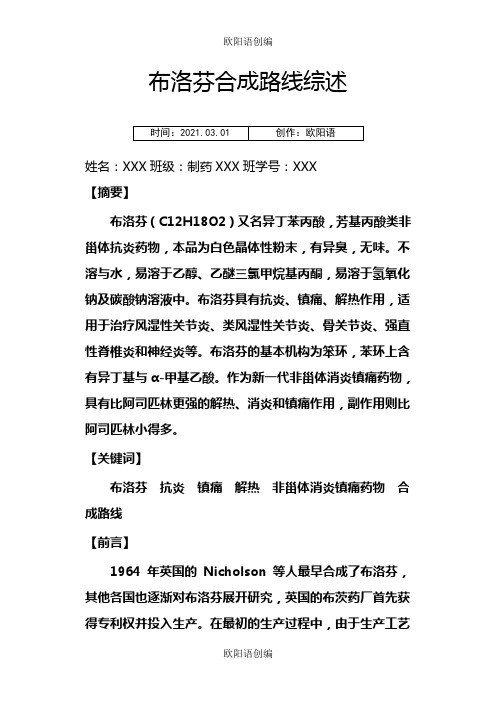
布洛芬合成路线综述姓名:XXX班级:制药XXX班学号:XXX【摘要】布洛芬(C12H18O2)又名异丁苯丙酸,芳基丙酸类非甾体抗炎药物,本品为白色晶体性粉末,有异臭,无味。
不溶与水,易溶于乙醇、乙醚三氯甲烷基丙酮,易溶于氢氧化钠及碳酸钠溶液中。
布洛芬具有抗炎、镇痛、解热作用,适用于治疗风湿性关节炎、类风湿性关节炎、骨关节炎、强直性脊椎炎和神经炎等。
布洛芬的基本机构为笨环,苯环上含有异丁基与α-甲基乙酸。
作为新一代非甾体消炎镇痛药物,具有比阿司匹林更强的解热、消炎和镇痛作用,副作用则比阿司匹林小得多。
【关键词】布洛芬抗炎镇痛解热非甾体消炎镇痛药物合成路线【前言】1964 年英国的Nicholson 等人最早合成了布洛芬,其他各国也逐渐对布洛芬展开研究,英国的布茨药厂首先获得专利权并投入生产。
在最初的生产过程中,由于生产工艺落后,导致布洛芬的生产成本高,产量低,企业规模受到很大限制。
直到20世纪80年代后期,随着羧基化法和1,2-转位法等布洛芬新工艺的出现,布洛芬的生产成本大大降低,企业的规模也越来越大。
目前,德国的巴斯夫公司,美国的Albemarle 公司和乙基公司都具有庞大的生产规模。
他们分别具有自己的核心技术,选择合适的工艺,从而具有经济效益和规模优势。
近十多年来,由于政府扶持,印度的医药工业发展迅速。
印度的Sumitra 公司和Cheminor 公司的生产规模也达到上述西方国家大公司的水平,而且由于印度的劳动力价格低廉,使得生产成本较低。
印度低价格的布洛芬大量出口,大大冲击了全球的布洛芬市场。
【研究现状】对于布洛芬这种医药结晶产品而言,质量的好坏对产品能否在国际市场竞争中占据有利地位往往起着重要的作用。
目前,国内布洛芬同国外同类产品相比存在着晶形不好、颗粒不均匀等质量方面的差距。
国内生产企业所使用的落后结晶技术与设备,一方面导致产品质量差,另一方面导致生产成本居高不下,使得国内布洛芬产品难以与国外产品相竞争,导致在国内市场和中国外的布洛芬产品占主导地位,如中美史可公司的布洛芬制剂占据了中国的70%的市场份额。
布洛芬合成路线综述之欧阳体创编
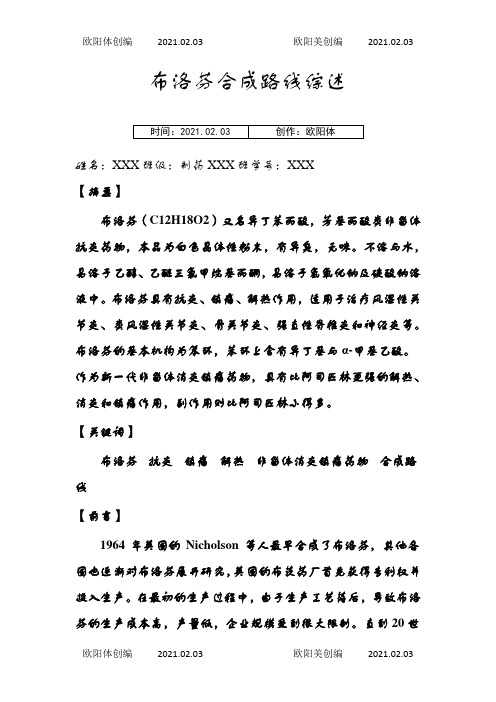
布洛芬合成路线综述姓名:XXX班级:制药XXX班学号:XXX【摘要】布洛芬(C12H18O2)又名异丁苯丙酸,芳基丙酸类非甾体抗炎药物,本品为白色晶体性粉末,有异臭,无味。
不溶与水,易溶于乙醇、乙醚三氯甲烷基丙酮,易溶于氢氧化钠及碳酸钠溶液中。
布洛芬具有抗炎、镇痛、解热作用,适用于治疗风湿性关节炎、类风湿性关节炎、骨关节炎、强直性脊椎炎和神经炎等。
布洛芬的基本机构为笨环,苯环上含有异丁基与α-甲基乙酸。
作为新一代非甾体消炎镇痛药物,具有比阿司匹林更强的解热、消炎和镇痛作用,副作用则比阿司匹林小得多。
【关键词】布洛芬抗炎镇痛解热非甾体消炎镇痛药物合成路线【前言】1964 年英国的Nicholson 等人最早合成了布洛芬,其他各国也逐渐对布洛芬展开研究,英国的布茨药厂首先获得专利权并投入生产。
在最初的生产过程中,由于生产工艺落后,导致布洛芬的生产成本高,产量低,企业规模受到很大限制。
直到20世纪80年代后期,随着羧基化法和1,2-转位法等布洛芬新工艺的出现,布洛芬的生产成本大大降低,企业的规模也越来越大。
目前,德国的巴斯夫公司,美国的Albemarle 公司和乙基公司都具有庞大的生产规模。
他们分别具有自己的核心技术,选择合适的工艺,从而具有经济效益和规模优势。
近十多年来,由于政府扶持,印度的医药工业发展迅速。
印度的Sumitra 公司和Cheminor 公司的生产规模也达到上述西方国家大公司的水平,而且由于印度的劳动力价格低廉,使得生产成本较低。
印度低价格的布洛芬大量出口,大大冲击了全球的布洛芬市场。
【研究现状】对于布洛芬这种医药结晶产品而言,质量的好坏对产品能否在国际市场竞争中占据有利地位往往起着重要的作用。
目前,国内布洛芬同国外同类产品相比存在着晶形不好、颗粒不均匀等质量方面的差距。
国内生产企业所使用的落后结晶技术与设备,一方面导致产品质量差,另一方面导致生产成本居高不下,使得国内布洛芬产品难以与国外产品相竞争,导致在国内市场和中国外的布洛芬产品占主导地位,如中美史可公司的布洛芬制剂占据了中国的70%的市场份额。
- 1、下载文档前请自行甄别文档内容的完整性,平台不提供额外的编辑、内容补充、找答案等附加服务。
- 2、"仅部分预览"的文档,不可在线预览部分如存在完整性等问题,可反馈申请退款(可完整预览的文档不适用该条件!)。
- 3、如文档侵犯您的权益,请联系客服反馈,我们会尽快为您处理(人工客服工作时间:9:00-18:30)。
镇痛消炎药布洛芬合成工艺的研究摘要布洛芬(ibuprofen),化学名为2一(4一异丁基苯基)丙酸,为新一代非甾体消炎镇痛药物,具有比阿司匹林更强的解热、消炎和镇痛作用,副作用则比阿司匹林小得多。
因此自上世纪70年代末上市以来,以其疗效高, 副作用小为特点而而获得了迅速发展,现已成为生产量和使用量最大的消炎解热镇痛药之一。
1987 年, 它在全部解热镇痛消炎药物的23 亿美元销售额中占18%的份额。
1993 年上升至30%以上。
目前,全世界布洛芬的总产量为8000 吨左右。
布洛芬的合成方法主要包括:(1)转位重排法;(2) 醇羰基化法;(3)烯烃羰基化法;(4) 卤代烃羰基化法;(5) 烯烃加氢法;(6)环氧丙烷重排法等。
本文以对异丁基苯甲醛为原料,分5步来合成布洛芬。
考察了反应气氛、温度、催化剂的量、溶剂等反应条件对反应的影响。
论文在对K4[Fe(CN)6]性质和苄氯氰化反应特点进行分析的基础之上,引入催化的方式,以无毒K4[Fe(CN)6]作为氰化试剂,实现了苄氯氰化反应中氰化试剂的无毒化,为苄氯向苯乙腈类化合物的转化探索了一种相对绿色的新方法。
温度对反应的影响如下:随着温度的升高,产率也随之升高。
但是,当反应温度高于某一反应温度时,产率又有所下降。
从动力学角度分析,我们可以知道:随着反应温度的升高,反应活性即反应速率也升高,催化剂的催化效率也升高,反应收到的产率也升高。
在某一温度附近达到最优化,之后继续升温使催化剂部分容易失活,并生成了其它副产物,反应的产率也随之下降。
因此该反应的最优反应温度是180 ℃。
在最优反应温度下,苯乙腈的产率可以达到97.8%。
考察了反应气氛对反应的影响。
发现当参与反应的物质的量很少时,在其它条件完全相同的情况下,无论是否有N2保护,产率基本相差不大。
但是从工业角度来说,反应物的量很大,可能会有各种情况出现。
所以,应以N2保护为最优条件。
总之,通过一系列的研究发现当在N2保护下,以PMHS为还原剂使对异丁基苯甲醛转变成醇,在SOCl2的作用下对其进行氯化。
使用无毒的K4[Fe(CN)6]作为氰化试剂在CuI催化下,于180℃下与苄氯发生反应得到的苄腈化合物水解制取布洛芬,取得了最佳效果。
关键词:布洛芬,对异丁基苯甲醛,碘化亚铜,亚铁氰化钾THE RESEARCH ON THE SYNTHESIS OFANALGESIC ANTI-INFLAMMATORY DRUGIBUPROFENTABSTRACTIbuprofen (ibuprofen), a chemical known as 2 (4 a isobutyl phenyl) propionic acid, as a new generation of non-steroidal anti-inflammatory analgesic drugs, with more anti-inflammatory and analgesic effects than aspirin antipyretic.Side effects are much smaller than aspirin. Therefore, since the late 70s of last century on the market, with its high efficacy and fewer side effects for the characteristics of and access to the rapid development, has become one of the largest production and use ofanti-inflammatory anti-inflammatory drugs. In 1987, it is accounted for 18% share in all the 2.3 billion sales for antipyretic analgesic anti-inflammatory drugs. 1993 increased to 30%. Currently, the world's total output of of ibuprofen is about. 8,000 tons.The synthesis of ibuprofen include: (1) translocation Rearrangement;(2) alcohol carbonylation; (3) olefin carbonylation; (4) halogenatedhydrocarbons carbonylation; (5) olefin hydrogenation Law; (6) rearrangement of propylene oxide method.This paper as raw material for iso-benzaldehyde, the synthesis of ibuprofen in 5 steps. The effect of reaction atmosphere, temperature, amount of catalyst, solvent and other reaction conditions on the reaction. Paper in K4 [Fe (CN) 6] reaction the nature and characteristics of benzyl cypermethrin on the basis of the analysis, the introduction of catalytic approach to non-toxic K4 [Fe (CN) 6] as the cyanide reagent to achieve the benzyl Cyanuric chloride reaction in non-toxic cyanide reagent for benzyl chloride to phenyl acetonitrile compounds into the green to explore a relatively new method.The impact of temperature on the reaction is as follows: as the temperature increases, production rate also increased. However, when the reaction temperature is higher than a certain temperature, the yield have declined. From the dynamic point of view, we can know: With the reaction temperature, the reaction activity of the reaction rate also increased, the catalytic efficiency is increased, the reaction also increased the yield received. Reaches a certain temperature near the optimum, and then continue to heat up some easy deactivation of the catalyst, and otherby-products generated, the reaction yield is lower. Therefore, the optimal reaction temperature is 180 ℃. Under the optimal reaction temperature, the yield of benzene acetonitrile up to 97.8%. .The effect of reaction atmosphere on the reaction. Found that the reaction of the small amount of substance, in the case of other conditions the same, regardless of whether N2 protection, the basic difference between the yield little. But from the industrial point of view, a large amount of reactants, there may be a variety of situations. So, should be protected for the optimal conditions N2In short, through a series of studies found that under the protection of the N2 to PMHS as the reducing agent to benzaldehyde on the iso into alcohol,the role of the SOCl2 its chlorination. Use non-toxic K4 [Fe (CN) 6] as the cyanide reagent in CuI catalyst at 180 ℃for reaction with benzyl chloride benzyl cyanide compounds obtained by hydrolysis to take ibuprofen, and achieved the best results.KEY WORDS: Ibuprofen,isobutylbenzaldehyde,cuprous lodide,Potassium ferrocyanide目录第1章前言 (1)§1.1布洛芬性质 (1)§1.2 铜催化腈化综述 (2)§1.2.1 铜催化剂简介 (2)§1.2.2 铜催化腈化反应 (3)§1.3 布洛芬生产工艺综述 (3)§1.3.1 转位重排法 (4)§1.3.2 醇羰基化法 (5)§1.3.3 烯烃羰基化法 (6)§1.3.4 卤代烃羰基化法 (6)§1.3.5 烯烃加氢法 (7)§1.3.6 环氧丙烷重排法 (8)第2章实验部分 (9)§2.1 原料与试剂 (9)§2.2 实验设备与仪器 (10)§2.2.1实验设备 (10)§2.2.2 实验仪器 (11)§2.3 试剂的纯化和处理 (11)§2.4 实验过程 (12)§2.4.1对异丁基苯甲醛合成对异丁基苯甲醇 (12)§2.4.2对异丁基苯甲醇合成对异丁基苄氯 (13)§2.4.3对异丁基苄氯合成对异丁基苯乙腈 (13)§2.4.4对异丁基苯乙腈合成α甲基对异丁基苯乙腈 (12)§2.5实验数据处理与分析的方法 (15)第3章结果与讨论 (19)§3.1反应气氛的影响 (19)§3.2 反应温度的选择.................. 错误!未定义书签。
